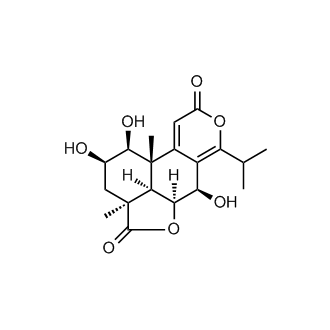| Size | Price | Stock |
|---|---|---|
| 1mg | $540 | In-stock |
| 5 mg | Get quote | |
| 10 mg | Get quote | |
| We match the lowest price on market. | ||
We offer a substantial discount on larger orders, please inquire via [email protected]
or Fax: (86)21-58955996
Inquiry for price and availability only. Please place your order via our email or fax.
| Cat. No. : | HY-N3216 |
| M.Wt: | 364.39 |
| Formula: | C19H24O7 |
| Purity: | >98 % |
| Solubility: | 10 mM in DMSO |
Nagilactone B is a liver X receptor (LXR) agonist. IC50 & Target: LXR[1] In Vitro: RAW264.7 cells are co-incubated with oxLDL (20 μg/mL) and Nagilactone B (0.02, 0.1, and 0.5 μM) for 24 h. Oil Red O (ORO) staining reveals significant lipid accumulation and foam cell formation in RAW264.7 cells following oxLDL treatment. Nagilactone B (NLB) significantly ameliorates intracellular lipid accumulation. ORO positive areas are reduced by 30.05±7.49 (P<0.01), 47.25±5.39 (P<0.001), and 48.65±7.44% (P<0.001) in Nagilactone B (0.02, 0.1, and 0.5 μM)-treated groups, respectively. The effects of Nagilactone B are evaluated ton cholesterol efflux. Nagilactone B (0.02, 0.1, and 0.5 μM) markedly promotes cholesterol efflux to extracellular apolipoprotein A-I (apoA-I) and high density lipoprotein (HDL) with maximal 5.72- (P<0.05) and 2.34-fold (P<0.01), respectively[1]. In Vivo: Nagilactone B (NLB) suppresses atherosclerosis in apoE-/- mice by inducing ATP-binding cassette transporter A1 (ABCA1) and G1 (ABCG1) mediated cholesterol efflux in macrophages. Male apoE-deficient mice on C57BL/6J background receive Nagilactone B (10 and 30 mg/kg) for 12 weeks. Compared with the model group, Nagilactone B treatment (10 and 30 mg/kg) significantly reduces en face lesions of total aorta areas. Six-week-old male apoE-/- mice on an HFD are randomized to receive Atorvastatin (10 mg/kg/day), Nagilactone B (10 and 30 mg/kg/day), or CMC-Na for 12 weeks. Mice on chow diet are administered CMC-Na as the normal diet control group. En face aortic lesion areas are evaluated with Sudan IV staining and lesion areas in the aortic sinus monitored via ORO staining. Atherosclerosis developes slowly in the normal diet group, whereas lesions in the HFD model group are significantly increased in en face aortas. Nagilactone B treatment (10 and 30 mg/kg/day) significantly reduces en face aortic lesions, compared with the HFD group by 54.96±10.06% (P<0.01), 71.50±15.37% (P<0.001) in both NLB (L) and NLB (H) groups. In particular, Nagilactone B markedly attenuates atherosclerotic plaque lesion areas in the aortic arch aorta, thoracic aorta, and abdominal aorta [P<0.01 in NLB (H) group][1].
Lorem ipsum dolor sit amet, consectetur adipisicing elit. Autem earum hic iste maiores, nam neque rem suscipit. Adipisci consequatur error exercitationem fugit ipsam optio qui, quibusdam repellendus sed vero! Debitis.
Inquiry Information- Product Name:
- Nagilactone B
- Cat. No.:
- HY-N3216
- Quantity:


Your information is safe with us.